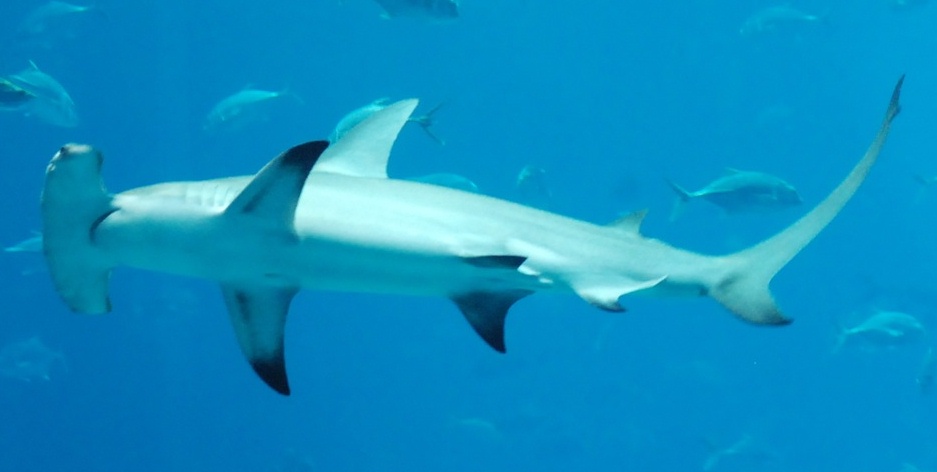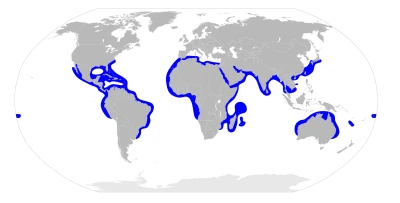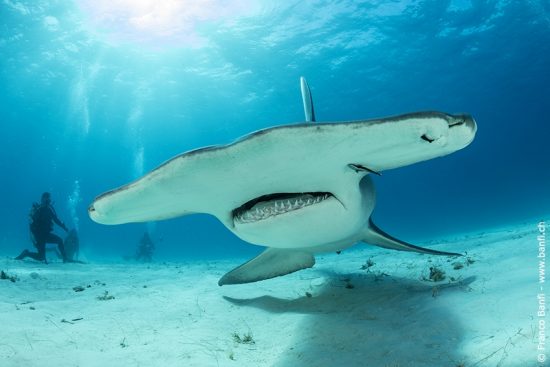Among all the sharks in the world great hammerhead shark (Spirna mokarran) it stands out for its unique appearance. Its broad, hammer-shaped head not only sets it apart from others, but also makes it one of the ocean's most efficient predators.

🔍 Main Features:
✔ It has a unique head in the shape of a hammer
✔ Has the best eyesight among sharks
✔ It is able to hunt the electrical impulses of its victims
✔ One of the largest hammerhead sharks, reaching 6 meters in length
Big Hammerhead Shark – the lone hunterwhich reigns supreme in warm ocean waters. It is there an important part of marine ecosystems, but due to overfishing it is on the verge of extinction.
Scientific classification
🔬 Classification of the Great hammerhead shark:
✔ The Kingdom: Animals (Animalia)
✔ Type: Chordal (Chordata)
✔ Class: Cartilaginous fish (Chondrichthyes)
✔ Row: Carcharine-like (Carcharhiniformes)
✔ Family: Hammerhead sharks (Sphyrnidae)
✔ Gender: Hammerhead sharks (Sphyrna)
✔ View: Big Hammerhead Shark (Sphyrna mokarran)
📌 Interesting!
Title Sphyrna from Greek it means "hammer", and mokarran it comes from Arabic and means "mighty".
Appearance and dimensions
📏 Main Features:
• Body length: 3.5-6 m, maximum value – 6.1 m
• Weight: 200-600 kg, highscore – 580 kg
• Life span: 20-30 years old
🎨 Color scheme:
• Grey or olive green back
• Light belly
🔍 Main differences from other sharks:
• A huge hammer-shaped head with very wide eyes
• Long, streamlined body
• High crescent-shaped dorsal fin
📌 Interesting!
The hammerhead shark's wide skull gives her best binocular vision among sharks, which allows you to track production with high accuracy.

Living environment
🌍 Where does the great hammerhead shark live?
• Warm tropical and subtropical oceans
• Atlantic, Pacific and Indian Oceans
• Coastal waters, coral reefs, lagoons, open ocean
🏝 Living conditions:
• Prefers warm water (above 22°C)
• It swims at depths from 1 to 80 m, but can dive up to 300 m.
• It can enter river mouths, but not fresh water
📌 Interesting!
Sometimes hammerhead sharks form temporary flocks of up to 100 individualsbut mostly they are they hunt alone.

Lifestyle and behavior
⚡ How does a large hammerhead shark hunt?
• Uses electroreceptors on the head to detect hidden victims
• Can sense prey even under the sand
• Thanks to the shape of the head, it performs fast maneuvers
🦈 Basic behavior:
• Active Day Hunter
• Hunts alone, rarely gathers in groups
• It can migrate long distances
📌 Interesting!
Big Hammerhead Shark the only hammerhead shark that feeds on other sharks!
Food
🍽 What does the great hammerhead shark eat?
• Tailpipe stingrays-favorite food
• Other sharks (including hammerhead sharks)
• Fish, squid, octopus, crabs
🔍 Hunting methods:
• With his "hammer" he presses the rays to the bottom
• Uses binocular vision for a precise attack
• Senses the electrical impulses of hidden prey
📌 Interesting!
Big Hammerhead Shark it is immune to stingray venomwhich allows her to eat them without fear!
Reproduction
👶 How does the great hammerhead shark breed?
• Viviparous
• Pregnancy lasts 10-11 months
• 6-55 cubs are born, each about 50 cm long.
📌 Interesting!
Unlike most sharks, female great hammerhead sharks can breed without a male. (parthenogenesis).

Human interaction
⚠ Is a large hammerhead shark dangerous?
• Usually avoids people
• Only a few attacks were recorded
• But because of the size, it can be dangerous
🎣 Hammerhead shark in fishing:
• It is caught through fins, which are used in soups
• Because of this, its population has declined by 80% over the past 50 years.
📌 Interesting!
Hammerhead Shark it is on the verge of extinction It is also listed on the IUCN Red List.
Interesting facts
📌 Top 5 Facts about the Great Hammerhead Shark:
1️⃣ It has better eyesight than any other shark.
2️⃣ Can sense victims ' electromagnetic fields
3️⃣ Its main spine is curved, which helps to maneuver quickly
4️⃣ It hunts venomous rays, as it is immune to their venom
5️⃣ A single hammerhead shark that eats other sharks
Conclusion
Big Hammerhead Shark (Sphyrna mokarran) – a unique hunter with unsurpassed sensory abilities. She one of the most effective predators of the ocean, but due to human activity, its population is it's shrinking dramatically.
🌊 This queen of the deep sea deserves to be preserved!